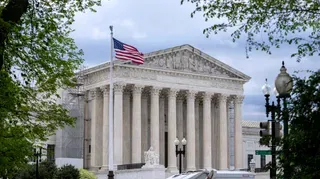December 16, 2010
It's Not Just the Smithsonian :: 'Gay' Art Censored at Canadian Library
Kilian Melloy READ TIME: 5 MIN.
Even as museums around the United States take a stand for freedom of speech and artistic expression by displaying the controversial "Ant Christ" video that the Smithsonian Institute censored, the public library in Tillsonburg, Ontario, has sparked outrage by covering over work by a gay sculptor.
The sculptor, R. Bruce Flowers, says that there is "nothing offensive or pornographic about" his work, and argues that his sculptures are being "eroticized" and censored simply because they are the work of "a gay man who sculpts positive images of his community," a Dec. 15 article at local newspaper the Tillsonburg News reported.
"What's going in Tillsonburg is kind of upsetting," Flowers told the newspaper. The library has hidden Flowers' sculptures--which were chosen specifically for their "family friendly" content--with cloths. Added Flowers, "This censorship is deeply distressing because of the negative message it sends out to the homosexual community. With this kind of hostility in their own community, what chance do young people have of making their transition into a homosexual lifestyle valid?"?
One piece, titled "Joy," shows one man riding the other piggyback. The playful piece has been unfairly "eroticized," according to Flowers. But the artist added that the fact that the piece has been censored feeds into the conversation that art enables in the culture at large. "We're not moving this exhibit," the artist told the media. "I think it would be a far more powerful statement to leave the cloth there if that's what they think."
Perhaps to that end, a sign attached to the cloth invites library patrons to "Feel free to view the display of sculpture (by artist R. Bruce Flowers) behind the curtain."
The article speculated that public opposition was largely based on--if not confined to--a Dec. 9 letter to the editor that the Tillsonburg News had previously published, in which a man named Greg Friesen complained about the library showcasing depictions of "homosexual intimacy."
The letter drew responses in the editorial pages such as that from Fr. Matthew George of St. Mary's Parish, who rebutted Friesen's claims by writing, "I'm guessing that the piece that elicits this strange response is the one called Joy. How doubly sad that something which to me seems to capture a moment of simple joy and shared humanity has been condemned as somehow advancing the homosexual agenda and not worthy of display in our library."
The library's board convened a meeting on the controversy, at which gay resident Dennis Cutts spoke out against the sculpture's veiling. "Personally I feel this decision by the library tells me I shouldn't feel as though I'm part of this community as a gay person," Cutts told the board. "I feel this is bullying. It makes me feel afraid and uncomfortable."
South of the Canadian border, the United States was embroiled in a higher-profile controversy over art, gay artists, and public spaces. An eleven-second segment of a four-minute excerpt from a 1987 half-hour-long video by the late artist David Wojnarowicz that depicts a crude crucifix being swarmed by ants overshadowed everything else in the privately-funded exhibit Hide/Seek: Difference and Desire in American Portraiture, which was on display at the Smithsonian Institute in Washington, D.C.
Conservative Catholic blogger William Donohue made the eleven-second segment the focus of a claim that the exhibit--and, by extension, the Smithsonian--was anti-Christian, even though art scholars understood the depiction to be part of a larger tradition in which bloody depictions of a brutalized Jesus on the cross underscore the suffering of God's son and the redemption, through pain and sacrifice, of humanity.
"If this is what they call art--never mind the pornographic images of gay men--and if this is how they treat Christians, then let them find private sources for their work," fumed Donohue, who failed to note that the exhibit had been privately funded.
Donohue went on to accuse the Association of Art Museum Directors of "rank hypocrisy" for failing to apologize adequately to offended Christians. "In 2006, it released a report on sacred objects, maintaining that 'art museums should strive to accord equal treatment and respect to all religions in the interpretation of religious works of art,' " the release said. "Does AAMD not regard a crucifix as a 'sacred object'? Christians would love to know. Or is their interest in 'sacred objects' limited to those found in 'indigenous societies,' as their policy seems to indicate?"
The office of incoming presumptive Speaker of the House John Boehner reportedly contacted the Smithsonian with threats of Republican retaliation against the Smithsonian, at which point the eleven seconds in question were excised from the video on Nov. 30. Arts advocates and free speech defenders instantly cried censorship. A spokesperson for Boehner reportedly called the exhibit a misuse of taxpayer money--again, without noting that taxpayers had not funded the exhibit.
Other Republican figures lost no time in jumping on the bandwagon. "This is an outrageous use of taxpayer money and an obvious attempt to offend Christians during the Christmas season," minority whip Eric Cantor told Fox News. "When a museum receives taxpayer money, the taxpayers have a right to expect that the museum will uphold common standards of decency. The museum should pull the exhibit and be prepared for serious questions come budget time."
New York Times columnist Frank Rich took aim at the Smithsonian for what he deemed it's complicity in Washington, D.C.'s culture of "homophobia." Write Rich, "It still seems an unwritten rule in establishment Washington that homophobia is at most a misdemeanor. By this code, the Smithsonian's surrender is no big deal; let the art world do its little protests."
Rich's column went on to excoriate Washington, D.C. further by saying, "Has it gotten better since AIDS decimated a generation of gay men? In San Francisco, certainly. But when America's signature cultural institution can be so easily bullied by bigots, it's another indicator that the angels Keith Haring saw on his death bed have not landed in Washington just yet."
The New York Times issued an institutional statement on the fracas in a Dec. 6 op-ed in which the paper called the Smithsonian's removal of the video clip "an appalling act of political cowardice," and went on to note that the show in which the piece appeared, "Hide/Seek: Difference and Desire in American Portraiture," was "a privately financed show [that] explores identity, gender and homosexuality in American portraiture." The op-ed also accused incoming House Speaker John Boehner of "bullying."
As reported by EDGE on Dec. 16, museums throughout the nation banded together in taking a stand and putting the excised video on display. One such museum was the Institute of Contemporary Art in Boston, Massachusetts. "We chose to show it as a way of not letting it become just a news story, a scandal," ICA chief curator Helen Molesworth told the Boston Globe. "We want to reclaim it as art, and to allow for the possibility of having an experience with it in a public museum."
Kilian Melloy serves as EDGE Media Network's Associate Arts Editor and Staff Contributor. His professional memberships include the National Lesbian & Gay Journalists Association, the Boston Online Film Critics Association, The Gay and Lesbian Entertainment Critics Association, and the Boston Theater Critics Association's Elliot Norton Awards Committee.






